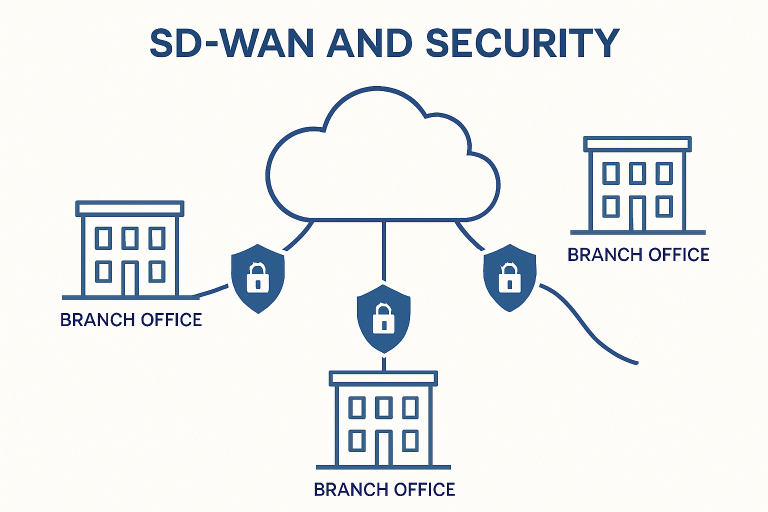Key Takeaways
- Modern enterprises need integrated networking and security to support distributed, cloud-first environments.
- SD-WAN improves connectivity, optimizes traffic routing, and ensures business-critical applications perform reliably.
- Embedding security within SD-WAN simplifies management, enforces policies in real-time, and reduces exposure to cyber threats.
- Cost-effective bandwidth usage and centralized orchestration help organizations scale efficiently while maintaining compliance.
- Industry-specific applications like finance and healthcare demonstrate the practical value of combining SD-WAN with security services.
Introduction
As organizations increasingly migrate to cloud-based solutions and support remote workforces, traditional networking and security approaches no longer meet the requirements of a modern, distributed IT environment. In response, businesses are now adopting integrated solutions that tie together networking and security, delivering improved operational agility and comprehensive data protection. By combining Software-Defined Wide Area Network (SD-WAN) with advanced security services, enterprises gain a seamless, unified platform to enhance network reliability and defend against evolving cyber threats. Integrated SASE management capabilities further streamline administration and security enforcement across distributed locations, making it easier to protect users and applications wherever they reside.
SD-WAN technology fundamentally changes how enterprises connect branches and remote sites to critical applications, optimizing traffic routing and reducing reliance on costly, legacy circuits. At the same time, the growing sophistication of cyberattacks and the proliferation of endpoints necessitate a security-first approach to network design. The convergence of these two pillars—network agility and end-to-end protection—enables organizations to meet the moment with agility and confidence.
Understanding SD-WAN
SD-WAN is an architecture that decouples how traffic is managed and routed from the traditional reliance on proprietary hardware and dedicated connections. Instead, it employs software control to direct application traffic across link types, including MPLS, broadband, and LTE. This enables traffic to move along the most efficient route based on current network conditions, driving superior performance for end-users and mission-critical applications. According to Forbes, SD-WAN’s virtualized control allows organizations to quickly adapt to traffic demands, scale up or down as needed, and maintain business continuity even as user needs shift.
The Need for Integrated Security
The rapid adoption of cloud, mobile access, and digital collaboration extends sensitive data and applications far outside the enterprise perimeter. This expansion exposes networks to new vulnerabilities, rendering perimeter-based defenses insufficient. Integrated SD-WAN and security services provide a holistic approach, applying controls beyond the datacenter and enforcing policy at every connection point. This is essential in preventing unauthorized access, data breaches, and lateral movement by malicious actors. Real-time threat intelligence, secure access controls, and ongoing monitoring are built into the network fabric, enabling organizations to respond instantly to emerging risks.
Benefits of Combining SD-WAN and Security Services
- Enhanced Performance: SD-WAN leverages intelligent traffic management to prioritize business-critical applications over less urgent traffic, dynamically routing data along optimal paths. This boosts user satisfaction and ensures uninterrupted operations, even during network congestion or outages.
- Improved Security Posture: Security functions such as next-generation firewalls, encrypted tunnels, and threat prevention are baked into the SD-WAN edge, diminishing exposure to attacks and reducing the complexity of standalone security tools. These capabilities provide real-time inspection and policy enforcement across all network traffic.
- Cost Efficiency: By using readily available broadband alongside more expensive dedicated circuits, organizations reduce connectivity costs while maintaining or improving application performance. Flexible bandwidth selection allows IT leaders to control spending without making performance trade-offs.
- Simplified Network Management: Centralized orchestration dashboards give IT professionals a single view to monitor network health, push configurations, and maintain compliance across all branch locations. This unifies disparate tools and reduces the time spent on troubleshooting and updates.
Industry adoption showcases the power of combining SD-WAN with integrated security services. For regulated verticals like finance, retail, and healthcare, these solutions enable secure, cloud-first connectivity that remains compliant with industry mandates. High-performing, secure networks are the foundation for digital transformation and support the scale and speed demanded by today’s hybrid workforce.

Real-World Applications
Organizations around the globe have leveraged SD-WAN alongside embedded security to support diverse operational challenges. In the financial sector, for example, minimizing downtime and ensuring the confidentiality of sensitive transactions is paramount. By consolidating network and security management, banks can speed up digital delivery and maintain strict regulatory compliance. Similarly, healthcare providers use AI-integrated SD-WAN solutions to protect patient data and meet HIPAA requirements, while maintaining optimal user experience for clinicians accessing cloud-based EMR systems. According to Forbes, this hands-on integration enables companies to go to market faster while safeguarding their assets against cyber threats.
Challenges and Considerations
While combining SD-WAN and security services delivers compelling benefits, the shift from legacy architectures is not without challenges. Organizations must choose providers with proven experience in both networking and security to ensure seamless integration. Scalability and ease-of-deployment must be balanced against the ongoing ability to respond to new attack vectors. Additionally, IT teams must plan for interoperability, ensuring new solutions coexist with existing infrastructure during migration. A holistic approach that includes continuous training, regular policy updates, and periodic risk assessments is essential for sustaining long-term value.
Final Thoughts
Integrated SD-WAN and security services represent a transformative step forward for enterprise IT, enabling high-performance connectivity while protecting users, devices, and applications wherever they operate. By embracing this unified strategy, organizations gain the agility, visibility, and scalability they need to succeed in the modern cloud era, while ensuring data privacy and business continuity in an increasingly complex threat landscape.
